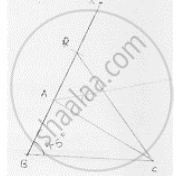Advertisements
Advertisements
प्रश्न
Construct a ΔABC in which AB + AC = 5.6 cm, BC = 4.5 cm, AB − AC = 1.5 cm and ∠B = 45°.
उत्तर

Steps of construction:
Step 1: Draw a line segment BC of 4.5cm
Step 2: At B, draw an angle XBC of 45°
Step 3: With center B and radius 5 6 , cm draw an arc which intersects BX at D.
Step 4: Join DC
Step 5: Draw the perpendicular bisector of DC which intersects BD at A.
Step 6: Join AC
∴ΔABC is a required triangle
APPEARS IN
संबंधित प्रश्न
Construct a triangle ABC in which BC = 7 cm, ∠B = 75° and AB + AC = 13 cm.
Construct a triangle ABC in which BC = 8 cm, ∠B = 45° and AB − AC = 3.5 cm.
Construct a right triangle whose base is 12 cm and sum of its hypotenuse and other side is 18 cm.
Construct a ΔABC in which BC = 3.6 cm, AB + AC = 4.8 cm and ∠B = 60°.
Using ruler and compasses only, construct a ΔABC, given base BC = 7cm, ∠ABC = 60° and AB + AC = 12 cm.
Construct a triangle whose perimeter is 6.4 cm, and angles at the base are 60° and 45° .
Using ruler and compasses only, construct a ΔABC from the following data:
AB + BC + CA = 12 cm, ∠B = 45° and ∠C = 60°.
Construct a triangle XYZ in which ∠Y = 30°, ∠Z = 90° and XY + YZ + ZX = 11.
The construction of a triangle ABC, given that BC = 6 cm, ∠B = 45° is not possible when difference of AB and AC is equal to ______.
The construction of a triangle ABC, given that BC = 3 cm, ∠C = 60° is possible when difference of AB and AC is equal to ______.
